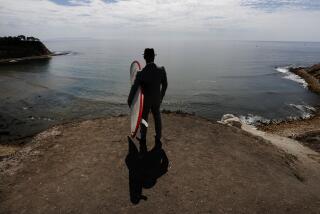HIGH HOPES : Hang Gliders Look to Soar Again at Dockweiler Beach
- Share via
To workers at the Hyperion sewage treatment plant in Playa del Rey, it will be just another place to park. But to hundreds of hang gliders throughout Southern California, a new parking lot at Dockweiler State Beach may mean they will fly again at the birthplace of their sport.
Construction is scheduled to begin this fall on the 500-space parking lot on a grassy swath near the treatment plant. The lot will be used over the next five years by Hyperion employees and construction crews during an expansion of the plant.
But Los Angeles city and county officials say the lot also is a crucial part of a plan to create a hang-gliding park at the beach that may open the area to the sport by the end of next year. Two years ago, the county closed Dockweiler south of Imperial Highway to hang gliders because of liability and safety concerns, including their habit of parking illegally along Vista del Mar.
In addition to the new parking lot, the plan calls for eventually developing launch pads for the gliders, rerouting a beachfront bicycle path and building restrooms and a concession stand.
Gentle Winds
The beach had been popular among hang gliders--particularly beginners--for more than 20 years because of its gentle and predictable coastal winds, a manageable 17-foot-high bluff for takeoffs and an abundance of soft sand to cushion landings. Hang-gliding enthusiasts have been pressing local officials for two years to allow their return to the beach, where they say the sport got its start in the late 1960s.
“Dockweiler has the same significance for the sport that Kitty Hawk, N.C., has for general aviation,” said Joe Greblo, a director of the 10,000-member U.S. Hang Gliding Assn. “The Wright brothers took their first flight on sand dunes in North Carolina and aviation was born. We had our first flights at Dockweiler beach and hang gliding was born.”
Construction of the beachfront parking lot, approved this week by the city’s Board of Recreation and Park Commissioners, represents the first part of a two-phase program to bring hang gliding back to Dockweiler.
“They are not asking for the sun and the moon,” said Susan Wagner, deputy to Los Angeles City Councilwoman Ruth Galanter, who represents the area. “They are just asking for a little bit of the bluff that they can use for their sport. It seems a shame not to be able to use the facilities.”
$3-Million Project
An aide to County Supervisor Deane Dana said the supervisor also supports bringing hang gliders back to Dockweiler.
Under the plan, the city will spend about $3 million to build the parking lot on seven acres west of Vista del Mar and to erect a pedestrian bridge connecting the lot and the treatment plant. At the same time, bulldozers will push dirt removed for the parking lot to a nearby bluff to create launching pads for the hang gliders.
Construction of the parking lot is crucial because parking problems were a key concern among county officials when they banned gliding there in 1987. Officials said hang gliders parked their cars illegally along Vista del Mar and dangerously lugged their 60-pound gliders across the street.
The lot will be open to hang gliders and other beachgoers on weekends and holidays, and will be turned over to the county exclusively for public use when a new employee parking garage is built at Hyperion within the next five years.
Hyperion has asked to build the parking lot because the plant expansion, which is needed to meet federal guidelines, will eliminate existing parking. Revenue from the new beachfront lot will be used to pay for a new lifeguard station at the beach, officials said.
Under the second phase, county planners are to draft, in the next six months, a blueprint for the beach and parking lot, which is expected to include an estimated $700,000 in other improvements, including the restrooms and concession stand. Critical to the plan will be a provision to reroute an existing bike path from the base of the bluffs to the eastern edge of the parking lot behind the glider pads.
Routine Approvals
Two years ago, county officials said the bike path was an important factor in their decision to ban gliding at the beach. Officials said they feared hang gliders unable to control their craft would collide with bicyclists below.
The blueprint must be approved by the city, county and state, but officials said the approvals are expected to be routine. Dockweiler is owned by the state and leased to the city, which in turn has a contract with the county to operate it.
The hang-gliding association has also been required to increase its liability insurance coverage from $500,000 to $1 million, which Greblo said the group has done. County officials said the group will also be required to monitor use of the hang-gliding area.
“There have been over a million flights there since the 1960s,” said Greblo, who taught classes at Dockweiler three times a week and is eager to return. “It has been real difficult the past two years.”
More to Read
Sign up for The Wild
We’ll help you find the best places to hike, bike and run, as well as the perfect silent spots for meditation and yoga.
You may occasionally receive promotional content from the Los Angeles Times.






